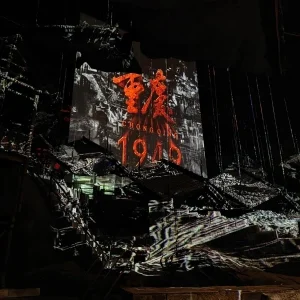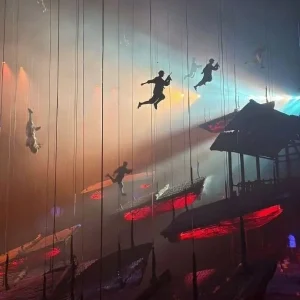4.7/5
China – Chongqing

Chongqing 1949 is a large-scale immersive theatrical performance that seamlessly blends advanced stage technology with compelling historical narratives. Set against the backdrop of Chongqing’s liberation in 1949, the show utilizes multi-dimensional visuals, a 360° rotating auditorium, and dynamic elements like water, fire, and lighting to deliver a profoundly moving experience. Whether you’re a history enthusiast or a fan of immersive theater, this production is a must-see.
Address: No. 999 Jinbi Zheng Street, Ciqikou Street, Shapingba District, Chongqing (Chongqing 1949 Grand Theater)
Showtimes: Performance times vary daily, typically starting at 19:30 or 20:00. Please refer to the official ticketing information for exact schedules.
Recommended Duration: Allocate approximately 2 to 2.5 hours, including entry procedures and the 90-minute performance.
Best Viewing Times: Suitable year-round; evening shows on weekends or holidays are recommended for an enhanced atmosphere, especially when combined with nearby night-time attractions.
Additional Notes:
The theater is indoors and operates regardless of weather conditions.
Advance online seat selection is advised; certain areas offer superior views and are ideal for photography.
Food and beverages are not permitted inside the auditorium; please dine beforehand or explore nearby eateries post-show.
Photography and videography during the performance are prohibited; please ensure mobile devices are silenced and respect theater etiquette.



Chongqing 1949 offers family-friendly pricing:
Children: Those under 1.2 meters in height can enter for free but must be accompanied by an adult. Height will be verified at entry.
Seniors: Individuals aged 65 and above are eligible for discounted tickets in specific seating areas (“Supreme” and “Guest” sections). Valid identification is required, and it’s recommended to check seat availability online in advance.
For groups including seniors or children, selecting premium seats ensures both comfort and optimal viewing.
The theater is centrally located in Yuzhong District, making it easily accessible:
By Bus: Routes 202, 209, 215, 237, 501, 503, 504, 553, 805, and 843 stop at “Jinbi Zheng Street Station.” The theater is a short walk from there.
By Subway: Take Chongqing Rail Transit Line 1 to “Ciqikou Station.” Exit from Exit 1 and walk approximately 200 meters to reach the theater.
By Taxi/Ride-Hailing: Input “Chongqing 1949 Grand Theater” into your navigation app. Most drivers are familiar with the location.
Given that performances typically occur in the evening, it’s advisable to allocate extra travel time, especially during weekends when traffic may be heavier.
Choosing the right seat can significantly enhance your experience:
Rotating Seats (Sections A & B): These seats rotate 360°, immersing you in the performance. Section A is closer to the stage, ideal for observing actors’ expressions. Section B is slightly elevated, offering a comprehensive view.
Fixed Seats (Sections C & D): These stationary seats are suitable for those who prefer minimal movement, such as seniors or young children. Section C offers central views, while Section D provides cost-effective options.
The theater’s design ensures clear sightlines and comfortable spacing across all sections.
Beyond the performance, the theater’s architecture is noteworthy. Its steel dome structure exudes a modern aesthetic, especially striking when illuminated at night—perfect for photography enthusiasts.
After the show, consider visiting the nearby Ciqikou Ancient Town. Wander through its stone-paved streets and traditional stilt houses for a contrasting experience of Chongqing’s rich history and culture.


Chongqing 1949 has garnered acclaim for redefining theatrical experiences. The theater accommodates over 1,500 spectators, with rotating seats that immerse the audience in the unfolding drama. Highlights include scenes of trains arriving, floods, and symbolic flag-raising, all executed with exceptional artistry. Visitors are advised to arrive at least 30 minutes early due to potential crowding at entry points.
To enhance your experience, we’ve compiled recommendations for optimal viewing angles, ideal showtimes, and nearby dining options. Consider pairing your visit with attractions like Jiefangbei Pedestrian Street, Hongya Cave, or the Yangtze River Cableway for a comprehensive day or evening itinerary that combines cultural immersion with scenic exploration.
Q: Can I purchase tickets on the day of the performance?
A: While same-day tickets may be available, popular time slots (such as evenings and weekends) often sell out. It’s advisable to book online in advance to secure preferred seating.
Q: Is the show suitable for children?
A: The performance is intense but not frightening. It’s recommended for audiences aged 6 and above. Children should be accompanied by an adult.
Q: Are photography and videography allowed during the show?
A: No. To maintain the integrity of the performance and respect fellow audience members, recording devices should be turned off, and photography is prohibited.
Q: Will the rotating seats cause discomfort?
A: The rotation is gradual and smooth, designed to enhance the immersive experience. Most attendees find it comfortable. If you have specific health concerns, consider selecting stationary seats located at the rear or sides of the auditorium.
Q: What language is the performance in?
A: The show is primarily in Mandarin. However, the visual storytelling and stagecraft transcend language barriers, making it accessible to non-Mandarin speakers.

 English (US)
English (US)